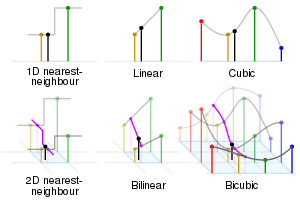Multivariate interpolation
In numerical analysis, multivariate interpolation or spatial interpolation is interpolation on functions of more than one variable.
The function to be interpolated is known at given points and the interpolation problem consist of yielding values at arbitrary points .
Multivariate interpolation is particularly important in geostatistics, where it is used to create a digital elevation model from a set of points on the Earth's surface (for example, spot heights in a topographic survey or depths in a hydrographic survey).
Regular grid

For function values known on a regular grid (having predetermined, not necessarily uniform, spacing), the following methods are available.
Any dimension
2 dimensions
- Barnes interpolation
- Bilinear interpolation
- Bicubic interpolation
- Bézier surface
- Lanczos resampling
- Delaunay triangulation
Bitmap resampling is the application of 2D multivariate interpolation in image processing.
Three of the methods applied on the same dataset, from 25 values located at the black dots. The colours represent the interpolated values.
 Nearest neighbor
Nearest neighbor Bilinear
Bilinear Bicubic
Bicubic
See also Padua points, for polynomial interpolation in two variables.
Tensor product splines for N dimensions
Catmull-Rom splines can be easily generalized to any number of dimensions. The cubic Hermite spline article will remind you that for some 4-vector which is a function of x alone, where is the value at of the function to be interpolated. Rewrite this approximation as
This formula can be directly generalized to N dimensions:[1]
Note that similar generalizations can be made for other types of spline interpolations, including Hermite splines. In regards to efficiency, the general formula can in fact be computed as a composition of successive -type operations for any type of tensor product splines, as explained in the tricubic interpolation article. However, the fact remains that if there are terms in the 1-dimensional -like summation, then there will be terms in the -dimensional summation.
Irregular grid (scattered data)
Schemes defined for scattered data on an irregular grid should all work on a regular grid, typically reducing to another known method.
- Nearest-neighbor interpolation
- Triangulated irregular network-based natural neighbor
- Triangulated irregular network-based linear interpolation (a type of piecewise linear function)
- Inverse distance weighting
- Kriging
- Gradient-enhanced kriging (GEK)
- Thin plate spline
- Polyharmonic spline (the thin-plate-spline is a special case of a polyharmonic spline)
- Radial basis function (Polyharmonic splines are a special case of radial basis functions with low degree polynomial terms)
- Least-squares spline
- Natural neighbour interpolation